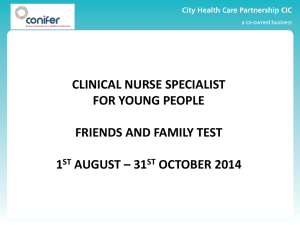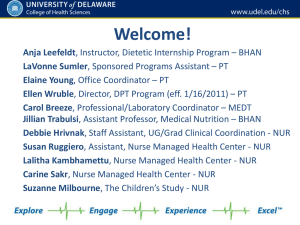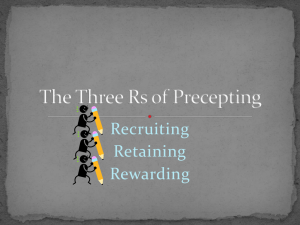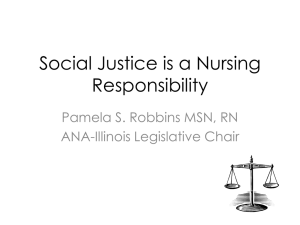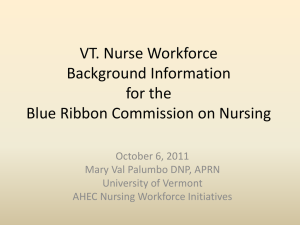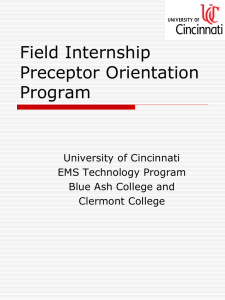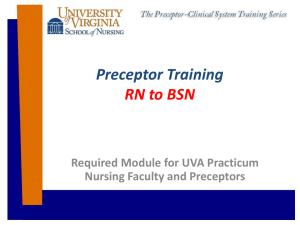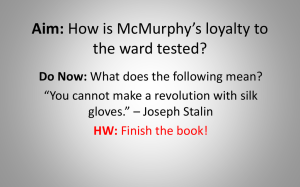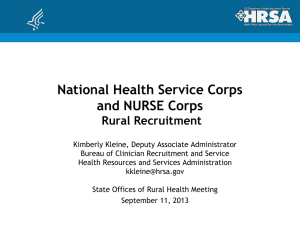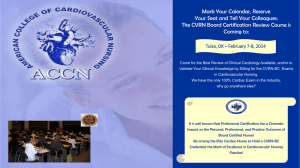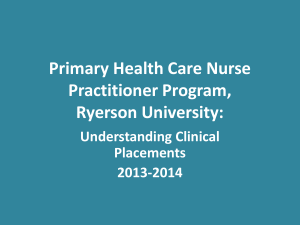A Development Program for Front Line Nurse Manager Preceptors
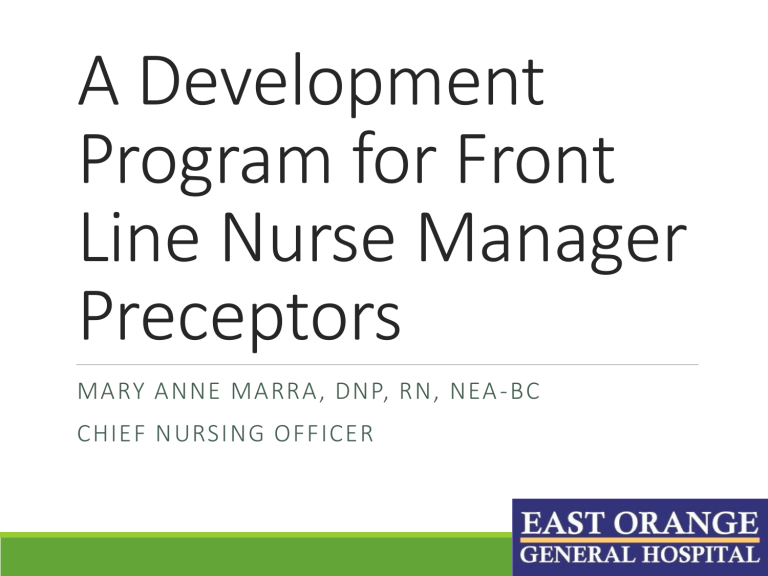
A Development
Program for Front
Line Nurse Manager
Preceptors
MARY ANNE MARRA, DNP, RN, NEA -BC
CHIEF NURSING OFFICER
Objectives
Discuss the process utilized to develop the nurse manager preceptor program
Review the measurement of pre-program and post-program change in leadership skills
Examine the implementation of the preceptor model with a small test of change with a new nurse manager
Present the nurse manager orientation tools developed during the program
Definitions
Front Line Nurse Manager (FLNM)
◦ Responsible for 24 operations of one or more units for patient care delivery
◦ Challenges of current healthcare environment, (Heller, Esposito-Herr, Tom,
2004)
Preceptor
◦ Facilitates acquisition of skills for role
◦ Student
◦ Entry level practitioner
◦ Advance Practice (McClure and Black, 2013)
Background and Significance
Significance of the Role of Nurse Manager
◦ Development of effective work team
◦ Create and sustain healthy work environment
◦ Outcomes
◦ Patient safety
◦ Customer Satisfaction
◦ Staff Satisfaction
◦ Increase in organizational effectiveness
(Sherman and Pross, 2010), (Warshawsky, Rayens, Stefaniak and Rahman, 2013), (Baxter and Warshawsky, 2014).
Nurse Manager Transition to
Role
The lack of a formal mechanism to orient new FLNM to the role impacts on:
◦ Properly prepare FLNM for the responsibilities
◦ Quality and Safety
◦ Resource Allocation
◦ Customer Service (Bressler and Fisher, 2012)
◦ Daily decisions regarding the cost of care delivery (McLarty and McCartney, 2009)
◦ Lack of FLNM engagement in the role and lead to job dissatisfaction and turnover
Identifying Preceptor
Participants
FLNM Preceptors recruited from four acute care hospitals in New Jersey
◦ Letter mailed to CNOs of acute care hospitals
◦ Participant deemed a competent NM, to serve as preceptor
Acute Care Hospitals NJ
◦ Have a FLNM that meets the criteria for participation
◦ 3 years or more experience in the role.
◦ Competent as per Benner’s model
◦ nurse who has been in the same job for 2-3 years,
◦ has the ability to consider long-term goals as they relate to actions
◦ gains perspective based on conscious, abstract and analytical thinking regarding the problem.
CNO’s in New Jersey have identified need for FLNM development
(Cadmus and Johansen, 2012)
AONE Framework
Healthcare Leadership Alliance
Competency Model, (Stefl, 2008)
Nurse Manager Leadership
Collaborative, AONE, AACN, AORN,
Learning Domain Framework
(Fennimore and Wolf, 2011)
Essentials of Nurse Manager
Orientation
Program Objectives
Create an FLNM Preceptor Training Program
◦ Develop FLNM preceptors for their role.
◦ Build upon competency as FLNM
◦ Build upon constructs of the Essentials of Nurse Manager Orientation
◦ Objectives:
◦ Increase FLNM preceptors’ ability to translate ENMO concepts into organizational specific practice and performance metrics as measured through pre and post program self-assessment utilizing the Nurse Manager Skills Inventory.
◦ Increase CNO evaluation of the FLNM preceptor skills as measured by pre and post program rating of the FLNM preceptor by the CNO utilizing the Nurse Manager Skills Inventory.
◦ Evaluate the congruence between the pre and post evaluation of the FLNM preceptor skills as reported in the Nurse Manager Skills Inventory assessment by the FLNM preceptor and the CNO.
◦ Demonstrate application of ENMO in the clinical setting as measured by the implementation of a financial skills project at the completion of the didactic session on the finance competency.
◦ Analyze the FLNM preceptors evaluation of the program.
Theoretical Framework
Patricia Benner
Novice to Expert
◦ Novice
◦ Advanced Beginner
◦ Competent
◦ Proficient
◦ Expert
As new FLNM assumes the new role they enter at the level of Novice
Competent manager a preceptor as per Benner definition
◦ nurse who has been in the same job for 2-3 years
◦ has the ability to consider long-term goals as they relate to actions
◦ gains perspective based on conscious, abstract and analytical thinking regarding the problem.
This helps the nurse to achieve greater efficiency and organization in the performance of tasks. ( Benner, 1984)
Literature Review
Search conducted using CINAHL, Medline and Business Source Primer databases
Concepts of
◦ 1) the relationship of the nurse manager role to quality outcomes and staff satisfaction
◦ 2) nurse manager competencies and nurse manager development
◦ 3) preceptors in nurse development and nurse manager preceptors
Manager Strong performance
◦ Critical Thinking (Zori, Nosek and Musil, 2010)
◦ Transformational Leadership Style (Casida and Parker, 2011).
◦ Positive work environment for staff and
◦ Improved outcomes (Boev, 2012)
Literature Review
Types of nurse manager leadership development programs
◦ Weekly informational meetings paired with peer coaching over a six month period (Codier, Kamikawa, and Molina Kooker, 2011)
◦ A nurse manager orientation program (Cohen, 2013)
◦ An online portal providing a repository of information for FLNMs (Parry, et. al., 2012)
◦ Didactic sessions to educate about leadership skills (Maryniak, 2011) A leadership development program for nurse managers based upon the Nurse
Manager Leadership Domain of AONE (Fennimore and Wolf, 2011)
◦ A yearlong program including:
◦ a 4 day workshop
◦ mentoring support over a one year period
◦ organizational support to implement leadership projects in the healthcare setting (McPhee, et. al., 2011)
Literature Review
Preceptors
◦ Other nurse managers
◦ Chief Nursing Officers
◦ Directors of Nursing
◦ Peer coaching (Hawkins, Carte and Nugent, 2009)
Preceptors must be competent to provide guidance(Palumbo, Rambur and Boyer, 2012)
Benner, Novice to Expert
◦ Found to be a framework to structure nurse manager development from novice to expert
Methods
Setting and Target Population
◦ FLNM who are competent, based upon Benner (1984) definition
◦ Competent manager a preceptor as per Benner definition
◦ nurse who has been in the same job for 2-3 years
◦ has the ability to consider long-term goals as they relate to actions
◦ gains perspective based on conscious, abstract and analytical thinking regarding the problem.
FLNM who is person of choice to serve as preceptor for new FLNMs in the organization
Four 8 hour didactic sessions
◦ Build on the constructs of the Essentials of Nurse Manager Orientation ©
(ENMO © ) online program ( AONE, 2013)
◦ Prepare list and collate organizational documents, policies and procedures, forms to assist nurse manager during orientation.
Small test of change project
◦ Preceptors work with a new nurse manager in their respective organization on a change project, “Lead Your Team” constructs
Methods and Data
Pre and Post program assessment
◦ Nurse Manager Skills Inventory©
◦ Preceptor, pre, post program and two months post program completion
◦ Preceptor manager, pre and two months post program completion
◦ Nurse Manager Orientee, pre and post small test of change project
◦ Leadership Practices Inventory©
◦ Preceptor, pre and post program
◦ Nurse Manager Orientee, pre and post small test of change project
Demographic data collected on
◦ FLNM Preceptor
◦ New FLNM
◦ CNO
◦ Organization
Framework
Essentials of Nurse Manager Orientation ©
(AONE)
Patricia Benner (1984)
◦
Novice to Expert
Project Activities
Approval from the Rutgers University IRB for the implementation of the project.
Develop a curriculum for training of FLNM preceptors based upon the
ENMO content.
◦ Expand on the ENMO orientation content
◦ Discussion of specific examples of application of the principles within the organizations of the participants
◦ Organizational specific documents
◦ Policies
◦ Procedures
◦ Forms
◦ Anecdotal examples
Project Activities
Recruitment of Participants
◦ Recruited from 4 acute care hospitals
◦ Letter mailed to acute care hospital CNOs
◦ One successful recruitment
◦ Personal emails to two CNOs
◦ One successful recruitment
◦ One un-successful for recruitment
◦ Concerned about time commitment for the participation in the program for a nurse manager
◦ One connection through director of education to CNO
◦ Telephone interviews with CNOs to discuss program and confirm commitment
◦ CNOs identified nurse manager participants
◦ CNOs agreed to pay tuition for ENMO curriculum
◦ Telephone interviews with participants to discuss program participation, ENMO program and data requirements
◦ Email communication to establish best dates for program meetings.
Project Activities
Participants completed modules of the ENMO
Four 8 hour didactic meetings, November 15, 18 and December 5 and
13 th .
Discussion of the ENMO topics
Discussion and brainstorming of list of “items” needed for a nurse manager orientation
◦ Developed into list to of items to be collated into orientation book
Discussion of activities for a new nurse manager to complete during orientation
◦ Developed into Nurse Manager Orientation Checklist
Evaluation Plan
Methods/Indicators
◦ Demographics
◦ Nurse Manager Skills Inventory
◦ Change over time pre and post program by the
◦ Preceptor
◦ Manager
◦ Manager orientee
◦ Comparison of Preceptor and Manager evaluation
◦ Leadership Practices Inventory
◦ Change over time pre and post program
◦ Preceptor
◦ Manager Orientee
◦ Project Implementation by preceptor with new FLNM
◦ Lead the People project completed by new manager with preceptor
◦ Post program evaluation by completed by the preceptor
Demographics
Preceptor
Age
Sex
Ethnicity
Years as Registered Nurse Range 21-32 years
Median= 22 years
Months/Years as Nurse
Manager/CNO
Range 6-28 years
Median= 10.29 years
Months/Years in current position Range 3-6.5 years
Median= 5.25 years
Highest level of nursing education( select one below)
BSN = 2
MSN= 1
MS other = 1
Certification, Yes/No
Range 45-54
Median= 50.5
F = 4
M= 0
Asian = 1
Black/African American= 2
White = 1
Title of Certification
Number of years certified
Yes= 3
No = 1
CNML= 1
Oncology Nurse= 1
Gerontology Nurse =1
Range 1.5 to 9 years
Median= 3.0 years
CNO
Range 30-45
Median= 34.0
F = 3
Male = 1
Asian = 1
Black/African American = 1
White = 2
Range 8-24 years
Median = 8 years
Range 2.5 months to 4 years
Median = 5.5 months
Range 2.5 months- 9 months
Median = 0.46years
BSN = 3
MSN= 1
Yes = 3
No = 1
Range 1-6 years
Median= 4.0 years
Orientee
Range 58-59
Median= 58
F = 4
Male= 0
White = 4
Range 36-39 years
Median= 37.0
Range 4-17 years
Median= 6.04
Range 1.4 -10 years
Median= 4.13 years
MSN= 2
MS other= 1
DNP=1
Yes = 4
NE-BC = 1
NEA-BC= 2
CPHQ= 1
Range 5-23 years
Median= 10.5 years
Demographics
Previous Experience
Orienting Nurse Managers
Number of manger oriented
Oriented to role of manager
Preceptor
Yes= 3
No= 1
Range 3-6
Duration of Orientation
Orientee
Yes= 1
No= 2
One participant did not respond
2.5 months
Only one participant responded
Organizational Demographics
Hospital Type:
Licensed beds
Number of Maintained beds
Magnet Designated
On Magnet Journey
Organization Demographics
Not for profit = 4
Teaching = 2
Non-teaching = 2
Range 178-651 beds
Range = 155-500
Yes = 3
No = 1
No = 1
Pathway to Excellence Designated
On Pathway to Excellence Journey
Number of Front Line Nurse Managers (FTEs)
Number of Front Line Nurse Manager vacancies
Number of Front Line Nurse Managers hired in the past two years
Formal Orientation for Front Line Nurse Managers
Duration of formal orientation for FLNM
No = 4
Yes = 1
No = 3
Range 8-26
Mean = 18
Range 0-1
Mean= 0.25
Range 3-8
Mean = 4.75
Yes = 2
No = 2
Range 3-12 weeks
Nurse Manager Skills Inventory
American Association of Critical Care Nurses (2006), retrieved from: http://www.aacn.org/wd/practice/docs/nurse-manager-inventory-tool.pdf
Nurse Manager Skills
Inventory
©
Score Change by Preceptors
Manage the Business
Time 1, Time 2 and Time 3
Nurse Manager Skills
Inventory
©
Score Change by Preceptors
Lead the People
Time 1, Time 2 and Time 3
Nurse Manager Skills
Inventory
©
Score Change by Preceptors
Creating the Leader Within Yourself
Time 1, Time 2 and Time 3
Nurse Manager Skills
Inventory
©
Score change by role
Manage the Business
Time 1 and Time 2
Nurse Manager Skills
Inventory
©
Score change by role
Lead the People
Time 1 and Time 2
Nurse Manager Skills
Inventory
©
Score change by role
Creating the Leader Within Yourself
Time 1 and Time 2
Nurse Manager Skills Inventory ©
Domain
Managing the Business
Subsection
Financial Management
Human Resource Management
Performance Improvement
Foundational Thinking Skills
Technology
Strategic Management
Appropriate Clinical Practice Knowledge
Potential Maximum
Score
55
Mean T1
35
20
25
30
45
5
P = 33.88
M = 36.50
O = 21.63
P = 25.13
M = 30.00
O = 18.75
P = 14.00
M = 15.75
O = 11.25
P = 16.25
M = 19.00
O= 14.00
P = 21.75
M = 22.75
O = 19.00
P = 27.63
M = 27.75
O = 21.88
P = 3.75
M = 4.00
O = 2.75
Mean T1
P = 40.00
M = 41.50
O = 26.00
P = 27.50
M = 32.75
O = 21.50
P = 15.25
M = 17.00
O = 13.25
P = 19.00
M = 20.00
O = 16.50
P =23.50
M = 24.75
O = 22.75
P = 32.75
M = 29.00
O = 27.13
P = 4.00
M = 4.50
O = 3.00
Domain
Nurse Manager Skills
Inventory
©
Subsection Potential Maximum
Score
Mean T1
Leading the People Human Resource Leadership Skills 25
Relationship Management and Influencing Behaviors 45
Diversity
Shared Decision Making
15
10
P = 17.75
M = 20.75
O = 13.50
P = 29.75
M = 36.25
O = 22.00
P = 10.50
M = 13.75
O = 8.75
P = 7.75
M = 8.50
O = 5.75
Mean T1
P = 19.75
M = 22.50
O = 16.75
P = 31.25
M = 37.50
O = 29.50
P = 12.00
M = 14.50
O = 11.75
P = 8.25
M = 9.50
O = 8.00
Domain
Nurse Manager Skills Inventory ©
Subsection
Creating the Leader in Yourself Personal and Professional Accountability
Career Planning
Personal Journey Disciplines
Reflective Practice Reference Behaviors/Tenants
Potential Maximum
Score
Mean T1
20
15
15
45
P = 14.00
M = 17.00
O = 12.25
P = 10.25
M = 12.50
O = 8.75
P = 10.00
M = 12.00
O = 8.00
P = 30.75
M = 39.75
O = 28.75
Mean T1
P = 16.25
M = 17.00
O = 15.00
P = 12.25
M = 12.75
O = 10.50
P = 12.00
M = 13.50
O = 10.75
P = 36.25
M = 41.50
O = 35.75
Preceptor and Manager
Comparison
Managing the Business Time 1 Preceptor/Manager Score Managing the Business Time 2 Preceptor/Manager Score
164,5
180
149,5
132
110,5
159
145
152
160
206
156
144
169
165 163 163
1 2 3
Preceptor Manager
4
1 2 3
Manager
4
Preceptor and Manager
Comparison
Leading the Team Time 1 Preceptor/Manager Score Leading the Team Time 2 Preceptor/Manager Score
80
95
72
60
50
94
75
85
75
95
74
76
75
94
77
89
1 2 3
Preceptor Manager
4
1 2
Preceptor
3 4
Preceptor and Manager
Comparison
Creating the Leader in Yourself Time 1
Preceptor/Manager Score
Creating the Leader in Yourself Time 2
Preceptor/Manager Score
74
88
62 61
77
73
80
37
71
89
67 67
72
79
81
85
1 2 3
Preceptor Manager
4
1 2 3
Preceptor Manager
4
Leadership Practices Inventory
“How frequently do I engage in the behavior described?”
1) almost never, 2) rarely, 3) seldom, 4) once in a while, 5) occasionally, 6) sometimes, 7) fairly often, 8) usually, 9) very frequently, 10) almost always
Kouzes, J. and Posner, B. (2013), retrieved from: http://www.leadershipchallenge.com/UserFiles/LPISelfSampleReport-
Aug2013.pdf
, used by permission
Leadership Practices Inventory
©
Change over time
Preceptor and Orientee
Time 1 and Time 2
Leadership Practices Inventory
©
Preceptor
LPI Total
Change T1 to T2
Orientee
LPI Total
Change T1 to T2
Leadership Practices Inventory
©
T2 Exemplary Leadership Practice Total Possible
Score
T1 Change in Mean
Model the Way
Inspire a Shared Vision
Challenge the Process
Enable the Way
Encourage the Heart
60
60
60
60
60
P =52.75
O = 50.00
P = 51.5
O = 50.50
P = 49.25
O = 50.00
P = 51.00
O = 50.75
P = 51.50
O =52.25
P = 52.75
O = 54.50
P = 51.75
O = 52.50
P = 50.25
O = 53.75
P = 54.25
O = 54.50
P = 49.25
O = 55.50
P = 0
O = 4.5
P = 0.25
O = 2.0
P = 1.0
O = 3.75
P = 3.25
O = 3.75
P = -1.25
O = 3.25
Program Evaluation
Five-point Likert scale, strongly agree, agree, neither agree or disagree, disagree, strongly agree:
1.
The program has increased my understanding of the nurse manager skills.
2.
The program has increase my ability to present concrete examples of nurse manager skills to a nurse manager orientee.
3.
The program has increased my confidence to serve as a nurse manager preceptor.
4.
The program has increase my confidence in my role and performance of my job as a nurse manager.
5.
Overall I found this program helpful to my role as a nurse manager preceptor.
ALL Strongly Agree
Comments
“I wish I had this course when I became a new manager.”
“It was a great review for me as a manager with many years of experience. I have found I can never say you know it all. It helped to clarify some areas like finance that I may be weak and to reinforce areas that I may be doing really well. Thanks for the opportunity to be a part of a very needed tool for new nurse managers.”
“This program validated, taught, and has given me a better idea/insight to do a more thorough job in orientating new nurse managers.”
“This program gave me the opportunity not only to learn to precept a new manager, but also to evaluate where I am as a Leader and see areas where I am doing well and I can make some improvements. Thank you for this privilege.”
The Front Line Nurse Manager Preceptor Assignment with a
Front Line Nurse Manager
Principles and Elements of a Healthful
Practice/Work Environment (AONE, 2004)
1.
Collaborative Practice
2.
Improving Communication
3.
Accountability
4.
Qualified nurses
5.
Leadership
6.
Shared Decision making
7.
Growth and Development
8.
Valuing nursing
9.
Meaningful recognition
Six Month Action Plans
Collaborative Practice
◦ monthly staff meetings with discussion of goals and outcomes for the unit
◦ shared governance reports at staff meetings
◦ discussion among unit leadership of progress toward unit goals and staff strengths and weaknesses
◦ meeting with departments leaders of other departments to develop relationship for mutual goals that impact patient flow
◦ a detailed and specific plan to work with other departments to establish a video EEG program
Improving Communication
◦ holding 1:1 staff meetings with all staff members
◦ implementing an open door policy for staff
◦ establishing a unit communication board, providing staff with education tools to improve communication
◦ surveying staff members of preferred method of communication
◦ establishing a communication tree for staff in the staff lounge
◦ implementing TeamSTEPPS strategies of briefings and huddles daily on the unit
Developing Accountability
◦ involving staff in the development and review of the unit staffing plan
◦ assessing staff involvement in bedside shift report
◦ increasing staff accountability to manage attendance and punctuality through manager coaching
◦ involving staff in an improvement process to decrease undocumented medications
◦ providing staff with freedom to collaborate with other staff members for task completion
Six Month Action Plans
Staff involvement-qualified nurses
◦ Encouraging staff self-scheduling and time trading to decrease absenteeism
◦ improving communication with charge nurses to increase comprehension of the staffing budget
◦ flexing of unit staffing based upon patient acuity
Leadership
◦ to be fair and respectful when interacting with staff
◦ to work to better understand personal strengths and weaknesses and then continue to build leadership skills
◦ to attend leadership development programs
◦ to work toward a transformational leadership style
Shared decision making
◦ encouraging staff input for unit decision making
◦ support active unit council
◦ work with staff to develop goals for the unit
◦ share data with staff (NDNQI) and share information from nursing councils, PI, Patient Satisfaction and Professional
Practice Council
Six Month Action Plans
Growth and development
◦ encourage staff to attend classes offered by the organization and to seek national certification
◦ cross train staff to other positions
◦ develop a succession plan
◦ encourage professional organization participation
◦ encourage staff to attend formal education for advancement and flex schedule for school attendance
Valuing nursing
◦ assuring unit participation in all of the nursing department councils
◦ developing a functioning shared governance model on the unit
◦ providing staff time to attend council meetings
◦ encourage staff to attend hospital-wide committees
Six Month Action Plans
Meaningful recognition
◦ creating a reward system for staff
◦ implement an appreciation board on the unit
◦ encourage staff to nominate others for awards
◦ develop a unit based employee of the month program, encourage peer nominations for the hospital employee of the month and the Daisy award
◦ acknowledge staff accomplishments at staff meetings
◦ send personal thank you notes to staff
◦ acknowledge staff personally for patient comments on nurse manager rounds and satisfaction surveys
◦ unit based celebrations of birthday, life events and holidays
◦ “caught in the act” recognition of staff for positive customer feedback
◦ “Hearts of Healing “unit board for staff recognition
Program Outputs
Nurse Manager Orientation Document list
Nurse Manager Orientation Checklist
Meet and Greet Checklist
FLNM preceptors to bring tools back to organization
◦ Orient new managers
Limitations
Program size
◦ 4 preceptor participants
Program duration
◦ Measure of impact to future nurse managers in the participating organizations
Future Considerations
FLNM preceptors to bring tools back to organization
◦ Benefits to Program Participants
◦ Orient new managers
Training additional FLNM preceptors in the future
◦ Repeat the program with additional nurse manager preceptors
◦ Add to the ENMO content of AONE
Questions
References
American Organization of Nurse Executives. (2012). Essentials of Nurse Manager Orientation; . retrieved from; http://www.aacn.org/wd/elearning/content/enmo/enmohome.pcms?menu=elearning
American Association of Critical Care Nurses (2006), retrieved from: http://www.aacn.org/wd/practice/docs/nurse-manager-inventory-tool.pdf
Balasco Cathcart, E., Greenspan, M., & Quinn, M. (2010). The making of a nurse manager: the role of experiential learning in leadership development.
Journal of Nursing Management, 18, 440-447.
Benner, P. (1984). From Novice to Expert, Excellence and Power in Clinical Nursing Practice. Menlo Park, California: Addison-Wesley Publishing Company.
Boev, C. (2012). The Relationship Between Nurses' Perception of the Work Environment and Patient Satisfaction in Adult Critical Care. Journal of Nursing
Scholarship, 44, 368-375.
Bressler, T.&Fisher, M. (2012), Leading Into the Future. Nursing Management, November, 10-12.
Cadmus, E., & Johansen, M. L. (2012). The Time is Now: Developing a nurse manager residency program. Nursing Management, 43, 18-24.
Casida, J., & Parker, J. (2011). Staff nurses perceptions of nurse manager leadership styles and outcomes. Journal of Nursing Management, 19, 478-486.
Codier, E., Kamikawa, C., & Molina Kooker, B. (2011). The Impact of Emotional Intelligence Development on Nurse Managers. Nursing Administration
Quarterly, 35, 270-281.
Fennimore, L., & Wolf, G. (2011). Nurse Manager Leadership Development, Leveraging the Evidence and System-Level Support. Journal of Nursing
Administration, 41, 204-210.
Hawkins, A., Carter, K., & Nugent, M. (2009). Nurse Manager Orientation. AACN Advanced Critical Care, 20, 55-70.
Kouzes, J. and Posner, B. (2013), retrieved from: http://www.leadershipchallenge.com/UserFiles/LPISelfSampleReport-Aug2013.pdf
, used by permission
References
Mackoff, B. L. (2011). Nurse Manager Engagement. Sudbury: Jones and Bartlett Publishers.
MacPhee, M., Skelton-Green, J., Bouthillette, F., & Suryaprakash, N. (2011). An empowerment framework for nursing leadership development: supporting evidence. Journal of Advanced Nursing, 68, 159-169.
Maryniak, K. (2013). Development of Training for Frontline Nurse Leaders From Assessment to Results. Journal of Nurses in
Professional Development, 29, 16-18.
McLarty, J. & McCartney, D. (2009). The Nurse Manager the Neglected Middle. Healthcare Financial Management, August, 74-80.
Palumbo, M., Rambur, B. A., & Boyer, S. A. (2012). Education and Employment Characteristics of Nurse Preceptors. The Journal of
Continuing Education in Nursing, 43, 472-480.
Parry, J., Calarco, M. M., Hensinger, B., Kearly, G., & Shakarjian, L. (2012). An Online Portal to Support the Role of the Nurse
Manager. Nursing Economics, 30, 230-232.
Shirey, M. R. (2007). Competencies and Tips for Effective Leadership, from Novice to Expert. Journal of Nursing Administration, 37,
167-170.
Zori, S., Nosek, L. J., & Musil, C. M. (2010). Critical Thinking of Nurse Managers Related to Staff RNs' Perceptions of the Practice
Environment. Journal of Nursing Scholarship, 42, 305-313.
Zwink, J. E., Dzialo, M., Fink, R. M., Oman, K. S., Shiskowsky, K., Waite, K., et al. (2013). Nurse Manager Perceptions of Role
Satisfaction and Retention at an Academic Medical Center. Journal of Nursing Administration, 43, 135-141.
